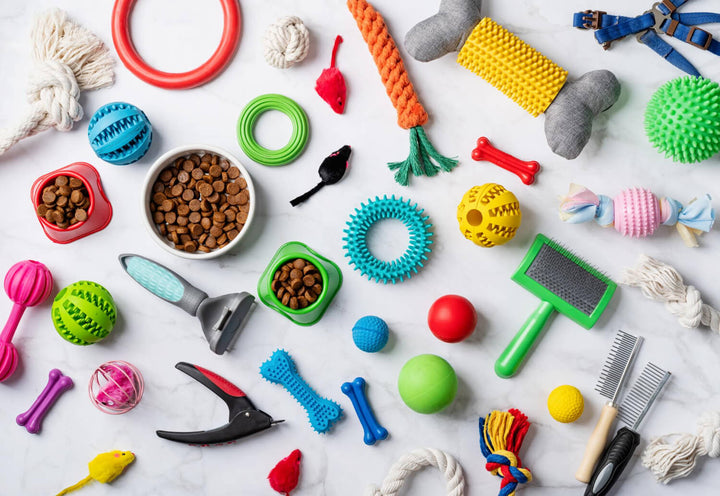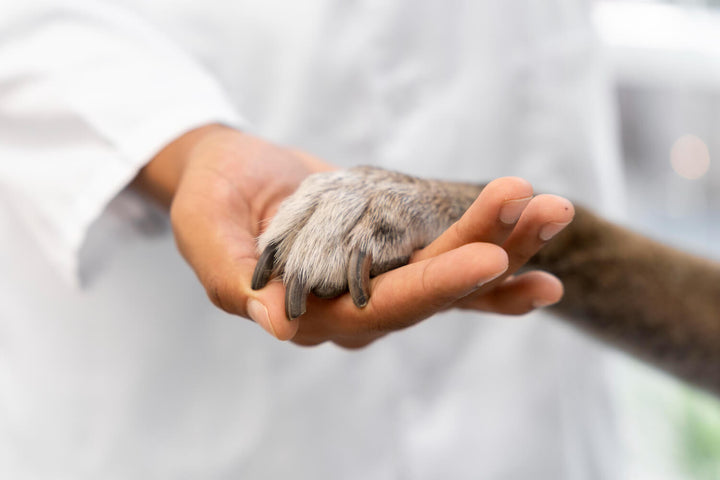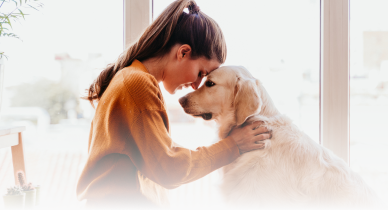Get ready to dive into the world of the Rottweiler, a breed that exudes strength, loyalty, and unparalleled presence. Known for their striking appearance and unwavering devotion, Rottweilers command attention wherever they go.
Did You Know these Facts about the Rottweiler?
-
The Rottweiler's roots date back to ancient Roman times, when they served as herding and guardian dogs for cattle on the journey to market. Their history is steeped in duty and companionship.
-
Beyond herding, Rottweilers have been employed in various roles throughout history, including pulling carts laden with goods and assisting police and military forces. Their versatility has contributed to their enduring popularity.
-
Rottweilers are often affectionately called "Rotties." This nickname captures their approachable and friendly nature while paying homage to their remarkable heritage.
-
With a powerful build and confident demeanor, the Rottweiler has become a symbol of strength and protection. Their imposing presence makes them ideal guardians and loyal companions.
- The Rottweiler's history as a guardian of herds and property still shines today. Their innate protective instincts and devotion to their families make them exemplary watchful companions.
Rottweilers hold a prominent position in the canine kingdom. Their popularity ranks them at #7 of the AKC´s top breeds, attracting enthusiasts who appreciate their distinctive attributes and unwavering loyalty. Their striking appearance and steadfast temperament contribute to their enduring appeal, making them sought-after companions.

Traits of the Rottweiler Breed
Overall Personality. Rottweilers are a harmonious blend of strength and gentleness. Their imposing presence belies a friendly and approachable nature. They are devoted, protective, and deeply loyal to their families, making them ideal companions for those seeking a steadfast friend.
Family Life. Rottweilers thrive in family settings, forming strong bonds with their human counterparts. They are affectionate with children and are known to be patient and tolerant, making them excellent playmates and guardians.
Physical Appearance. The Rottweiler's distinctive appearance features a robust and muscular build. Their glossy coat, usually black with rich tan markings, adds to their majestic allure. Their well-defined markings accentuate their powerful physique.
Sociability. Rottweilers possess a social and confident demeanor. Proper socialization from a young age is crucial to ensure they interact well with other pets and people, including small children. Their innate protectiveness extends to their interactions, making them watchful but respectful companions.
Average Sizes & Life Expectancy
- Height: 22 to 27 inches tall (56 to 58.5 cm)
- Weight: 80 to 135 pounds (36 to 61 kg)
- Life Expectancy: Around 9 to 10 years
Detailed Description of the Rottweiler Breed
Rottweilers are a breed that encapsulates strength, loyalty, and a remarkable history. From their origins as herders and protectors to their modern role as beloved companions, Rottweilers have left an indelible mark on the canine world.
Physical Appearance. The Rottweiler's appearance is a harmonious blend of power and elegance. Their robust, muscular build exudes strength and athleticism, with a deep chest and strong shoulders showcasing their working heritage. Their glossy double coat, typically black with tan markings, adds to their regal presence. The distinctive "eyebrow" markings above their eyes contribute to their expressive and intelligent gaze.
However, it's not just their physical attributes that make Rottweilers stand out. Their endearing traits elevate them to remarkable companions. A Rottweiler's heart is as big as their build, characterized by their unwavering loyalty, deep affection, and protective instincts.
Despite their imposing appearance, Rottweilers are known for their gentle and playful nature, especially with their families.
Temperament and Personality. Rottweilers possess a temperament that is as multifaceted as their history. They are loyal, devoted, and fiercely protective of their loved ones. Their inherent watchfulness makes them exceptional guardians, ready to defend their family and territory at a moment's notice. This protective instinct, coupled with their intelligence and discerning nature, makes them adept at assessing situations and responding accordingly.
Their loyalty extends beyond protection; Rottweilers form strong bonds with their families and are known to be affectionate companions. They thrive on human interaction, craving attention and companionship. With proper socialization from an early age, Rottweilers can coexist harmoniously with other pets and people, showcasing their adaptable and versatile nature.
Adaptability. Rottweilers are adaptable to a range of living environments, but their strong protective instincts make them particularly well-suited to homes where their watchful nature is valued. They excel in environments where they are treated as integral family members, receiving love, attention, and proper training.
Their size and strength may lead some to believe they're only suitable for experienced dog owners, and it is true that Rottweilers thrive under consistent guidance, positive reinforcement, and firm leadership. Their natural intelligence makes them quick learners, and their eagerness to please their owners fuels their training success
Care Guidelines. Nurturing a Rottweiler's well-being involves providing regular exercise to keep them physically and mentally engaged. Daily walks, play sessions, and interactive games satisfy their need for activity and companionship. Regular veterinary check-ups and vaccinations are crucial to monitor their health.
Grooming is relatively straightforward due to their short coat. Weekly brushing helps control shedding, and baths can be given as needed. Dental care is essential, as Rottweilers are prone to dental issues. Regular teeth cleaning and providing appropriate chew toys contribute to their oral health.
Training Strategies. Training a Rottweiler is a rewarding experience that channels their innate intelligence and desire to please. Early socialization is paramount to ensure they interact well with other pets, people, and various environments. Positive reinforcement techniques, consistency, and patience yield the best results. Obedience training not only refines their manners but also strengthens the bond between owner and dog.
Notable in History and Pop Culture. Rottweilers have a historical legacy that dates back to the Roman Empire, where they were invaluable herders and guardians. Their role evolved over centuries, from working alongside cattle to serving in police and military forces.
In pop culture, Rottweilers have made appearances in various films, showcasing their versatility and distinct presence. Their roles range from loyal companions to courageous protectors, reflecting their real-life attributes.
In conclusion, the Rottweiler's journey from ancient herder to modern-day companion is a testament to their enduring character and adaptability. Their imposing presence, loyalty, and protective instincts make them cherished family members and vigilant guardians. By understanding their history, embracing their traits, and nurturing their well-being, you'll unlock the full potential of this remarkable breed, forging a lifelong bond built on trust, companionship, and mutual respect.
What to expect when living with the Rottweiler Breed
Personality. Rottweilers' personalities are a blend of protector and playmate. Their loyalty and protective instincts are matched by their affectionate and gentle nature with their families. Their watchful demeanor makes them exceptional guardians, while their playfulness and devotion create lasting bonds. Early socialization is crucial to ensure they interact well with people and other animals.
Ideal Environment. Rottweilers thrive in homes where their presence is cherished and their protective instincts are valued. They adapt well to various living situations, from spacious houses with yards to apartments with dedicated exercise routines. Engaging them mentally and physically is essential, as they enjoy activities that challenge their intelligence and athleticism.
Maintenance Level. While Rottweilers have a short coat, regular grooming is necessary to keep shedding under control and their coat healthy. Weekly brushing removes loose hair and distributes natural oils, while baths can be given when needed. Pay attention to dental care, as they are prone to dental issues; regular teeth cleaning and chew toys contribute to oral health. Routine exercise and mental stimulation prevent boredom and maintain their well-being.
Overall Health Expectations and Best Health Tests for the Rottweiler Breed
Health Considerations. Rottweilers are generally healthy dogs, but like all breeds, they have certain health considerations. Some of the common health issues include hip and elbow dysplasia, heart conditions, and certain types of cancers. Regular veterinary check-ups are crucial to monitor their health and detect any potential issues early.
Recommended Health Tests. Health tests that are recommended for Rottweilers include hip and elbow evaluations, cardiac exams, and eye tests. These tests help identify any genetic or inherited conditions that may affect their well-being. Responsible breeding practices, including health screening of parent dogs, can contribute to healthier generations of Rottweilers.
Best Nutrition, Diet & Supplements for the Rottweiler Breed
Nutrition and Diet. Rottweilers are large and robust dogs with a powerful build, and their nutritional needs reflect their stature and activity levels. A high-quality commercial dog food formulated for large breeds is a solid foundation, as it takes into account their higher calorie requirements and includes essential nutrients for their growth and maintenance.
Protein is crucial for muscle development and repair. Look for a diet with a protein content of around 20-25%. High-quality animal protein sources, such as chicken, beef, and fish, support their muscle mass and provide essential amino acids.
Rottweilers are prone to joint issues like hip and elbow dysplasia. Foods rich in glucosamine and chondroitin can promote joint health and mobility. Additionally, omega-3 fatty acids found in fish oil have anti-inflammatory properties that benefit joint health.
Adequate fat content supports their skin and coat health. Omega-3 fatty acids further contribute to a glossy coat and skin hydration.
Carbohydrates, fats, and fiber are equally important. Opt for complex carbohydrates like whole grains, vegetables, and fruits, providing sustained energy levels.
Portion control is vital to prevent obesity, which can exacerbate joint issues. Follow the feeding guidelines on the dog food packaging and adjust based on your Rottweiler's activity level and age.
Hydration is Key. Ensure your Rottweiler always has access to fresh, clean water. Proper hydration is vital for digestion, temperature regulation, and overall vitality.
Supplements. Glucosamine and Chondroitin: These supplements support joint health and may alleviate symptoms of joint issues.Rich in omega-3 fatty acids, fish oil promotes skin health, reduces inflammation, and supports heart health.
Foods to Avoid. Certain human foods are harmful to Rottweilers. Chocolate, grapes, raisins, onions, garlic, and foods high in salt and fat can be toxic and lead to digestive issues. Keep these items out of reach and ensure your dog's diet consists of high-quality commercial or home-prepared dog food.
Grooming Requirements for the Rottweiler Breed
Grooming your Rottweiler goes beyond enhancing their appearance; it's about maintaining their health, hygiene, and well-being. This breed, admired for their strength and loyalty, has specific grooming requirements that contribute to their overall comfort and vitality.
Coat Maintenance and Shedding. Rottweilers have a short, dense double coat that provides protection against varying weather conditions. While shedding is moderate year-round, they experience heavier shedding during seasonal changes. Regular brushing, at least once or twice a week, helps manage shedding by removing loose hair and distributing natural oils for a healthy coat. Using a grooming tool like a slicker brush or a rubber curry comb is effective in reaching the undercoat.
Paw Care and Hygiene. Regularly inspect and clean your Rottweiler's paws, especially after walks or outdoor activities. Trim their nails every few weeks, ensuring you do not cut too close to the quick. Overgrown nails can cause discomfort and affect their gait.
Dental Care. Dental care is essential to prevent oral issues. Brush your Rottweiler's teeth several times a week using a dog-friendly toothbrush and toothpaste. Dental treats and toys can also contribute to their oral hygiene.
Bathing Frequency. Rottweilers are generally clean dogs that do not require frequent baths unless they get particularly dirty. Aim for a bath every few months, or as needed. Use a gentle dog shampoo to preserve their coat's natural oils and avoid causing dryness.
Exercise Required for the Rottweiler Breed
Rottweilers are powerhouse dogs that require consistent and structured exercise to channel their energy in positive ways. Engaging them in a variety of physical and mental activities ensures they remain content, well-balanced, and physically fit.
Rottweilers thrive on activities that tap into their innate strength and agility. Long walks or brisk jogs are essential to meet their exercise needs, and they enjoy accompanying you on outdoor adventures. Engage in activities like fetch, where their retrieval instincts shine, or involve them in canine sports like agility, tracking, and obedience trials.
Incorporating structured play sessions is vital to their mental and physical well-being. Tug-of-war, using sturdy ropes or toys, lets them flex their muscles and engage in interactive playtime. Puzzle toys challenge their problem-solving skills, and interactive feeders turn mealtime into an engaging mental exercise.
Many Rottweilers enjoy swimming, which is a low-impact exercise that provides a full-body workout. It's especially beneficial for dogs with joint issues, as it reduces stress on their joints while promoting cardiovascular health.
In addition to physical exercise, mental stimulation is key to preventing boredom and encouraging positive behavior in Rottweilers.
Training Tips for the Rottweiler Breed
Rottweilers are intelligent and eager to please, making them excellent candidates for obedience training. Basic commands like sit, stay, and come are foundational, enhancing their responsiveness and strengthening your bond.
Engaging your Rottweiler in agility training challenges their physical prowess and mental acuity. Setting up obstacle courses with jumps, tunnels, and weave poles keeps them engaged and sharp. Teaching them fun tricks like paw-shaking, rolling over, or playing dead provides mental enrichment and entertains both you and your dog.
Rottweilers possess a strong sense of smell and enjoy activities that allow them to use it. Scent work or tracking exercises involve hiding treats or toys for them to find, mimicking their natural instincts and providing mental stimulation.
Exposing your Rottweiler to different people, animals, and environments fosters well-rounded behavior. Puppy classes and group training sessions not only teach obedience but also offer opportunities for social interaction.
Do…
-
Use treats, praise, and affection to reward good behavior, reinforcing their desire to please you.
-
Be consistent in your commands and expectations. Use the same cues for specific behaviors and establish clear rules to avoid confusion.
-
Begin socialization from a young age, exposing them to various people, animals, and environments. This helps prevent fear and anxiety and contributes to their well-adjusted behavior.
-
Introduce more complex challenges to keep them engaged and stimulated. This also boosts their confidence and showcases their intelligence.
Don't…
- Use harsh training techniques that can damage their trust in you and lead to fear-based behaviors. Instead, focus on building a strong bond through kindness and patience.
The Rottweiler Breed is Suitable For
Rottweilers thrive in homes that provide them with ample space to move around and explore. They are adaptable to both urban and rural environments, as long as they receive regular exercise and mental stimulation.
Families with older children can enjoy the loyal companionship of a Rottweiler, provided the dog is socialized properly from a young age. Rottweilers often form strong bonds with their human family members and can be gentle and protective with children when raised in a loving and respectful environment.
They can coexist with other pets if introduced and socialized correctly, but supervision is crucial, especially with smaller animals.
The Rottweiler Breed is Not Suitable For
Rottweilers are not well-suited for homes where they are left alone for extended periods. They are social animals that form strong bonds with their human family members. Being isolated for long periods can lead to feelings of loneliness and boredom, which may manifest as behavioral issues like excessive barking, digging, or even separation anxiety.
Apartments without access to outdoor space can pose challenges for Rottweilers. These dogs require regular exercise to maintain their physical and mental well-being. Without ample room to move around and expend their energy, they may become restless and frustrated. Apartment dwellers considering a Rottweiler as a pet must be committed to providing them with multiple daily walks and engaging activities to compensate for the lack of a large yard.
Rottweilers are inherently protective and have a strong guarding instinct. While this quality can be an asset in the right environment, it can also lead to misunderstandings with strangers. Homes with frequent visitors should invest time in training and socialization to ensure that the dog learns to differentiate between welcome guests and potential threats. Early and consistent training can help them exhibit appropriate behaviors around unfamiliar people.
While Rottweilers can be gentle and affectionate with children, households with very young children need to exercise caution. Rottweilers are powerful dogs, and their exuberance during play could accidentally knock over or injure small children. Proper supervision and training are crucial to ensure that interactions between the dog and young children remain safe and positive.
If considering a Rottweiler as a companion animal, it's essential to assess your living situation and lifestyle to determine if it aligns with the breed's needs. If you work long hours, consider arranging for companionship during your absence through a dog walker, pet sitter, or enrolling them in doggy daycare. Living in an apartment requires a commitment to regular exercise, potentially involving multiple walks and play sessions each day.
Famous Rottweiler Owners
-
Will Smith - The actor and rapper Will Smith owned a Rottweiler named "Indo" in his early career. Indo appeared alongside him in the popular TV show "The Fresh Prince of Bel-Air."
-
Leonardo DiCaprio - Known for his love of animals, DiCaprio is a proud owner of a Rottweiler named "Baby" who frequently accompanies him on outdoor adventures.
- Hulk Hogan - The legendary professional wrestler Hulk Hogan owned a Rottweiler named "Max" who was often seen ringside during his matches, symbolizing strength and loyalty.
Accomplishments of the Rottweiler Breed
Rottweilers have a rich history as versatile working dogs. Originally bred as herding and guarding dogs, they excelled at tasks like pulling carts laden with meat to market. Today they were utilized as military, police and search and rescue dogs. They are considered to make great therapy dogs due to their gentle nature with proper training.
In pop culture, Rottweilers have made appearances in movies like "The Omen" and "Brewster's Millions," depicting their protective and loyal characteristics. Their iconic look and strong presence have made them symbolic figures in various forms of media.
In summary, Rottweilers are loyal companions best suited for families who can provide them with proper training, exercise, and socialization. Their protective instincts and versatile skills have led them to excel in various roles throughout history, making them beloved companions for those who understand and appreciate their unique qualities.

The History of the Rottweiler Breed
The history of the Rottweiler is steeped in a legacy of utility and companionship that spans centuries. Originating in the town of Rottweil in Germany, this breed has evolved from its humble beginnings as a versatile working dog to a beloved companion and protector cherished by families worldwide.
Creation and Purpose. The Rottweiler's lineage can be traced back to the Roman Empire when the legions traveled with their cattle and herding dogs, laying the foundation for the breed's herding instincts. The town of Rottweil, nestled on the banks of the Neckar River, became a bustling market center during medieval times. The Rottweiler's primary role was that of a cattle-driving dog, expertly guiding and guarding herds of livestock on their way to the market.
Early Roles and Evolution. As Rottweil grew in prominence, its markets flourished. The breed's versatility became evident as it not only excelled in herding but also gained a reputation as a capable and reliable guard dog. The breed was entrusted with protecting the valuable proceeds of the cattle sales, often carrying money in pouches around their necks. This earned them the moniker "Rottweil Metzgerhund," or "Rottweil butcher's dog."
With the advent of industrialization and changes in agriculture, the Rottweiler's role shifted. As railroads replaced cattle drives, the breed's herding duties diminished. However, their reputation as vigilant and protective dogs persisted. They found new roles as police dogs, search and rescue dogs, and service dogs due to their intelligence, loyalty, and ability to perform complex tasks.
Changes and Modern Impact. Over the years, the Rottweiler's physical characteristics evolved to suit its changing roles. The breed's sturdy frame, strong muscles, and distinctive black-and-tan coat became more defined. In the early 20th century, Rottweilers faced challenges in maintaining their working abilities due to the World Wars and changing agricultural practices. However, dedicated breed enthusiasts took strides to preserve the breed's heritage, focusing on maintaining its traits of strength, loyalty, and versatility.
Today, the Rottweiler is recognized as a versatile and multi-talented breed. They excel in various roles, from police and military work to therapy and assistance dogs. Their protective nature and loving disposition make them cherished family companions, ready to defend their loved ones while also offering unwavering loyalty and affection.
The Rottweiler Breed Standard
The Rottweiler falls under the Working Group according to the American Kennel Club (AKC). This group comprises breeds that historically performed various tasks, including guarding, herding, and pulling. Rottweilers' impressive strength and versatility align perfectly with this group's characteristics.
The American Kennel Club's formal breed standard for Rottweilers serves as a guideline for ideal conformation in dog shows. This standard outlines the specific physical traits, proportions, and characteristics that define the breed's essence. The Rottweiler's standard emphasizes its robust build, defined head shape, distinctive coat color, and other unique features that make it unmistakably a Rottweiler.
The Rottweiler Club of the United States (RCUS) is the national breed club dedicated to preserving and promoting the Rottweiler breed in the United States. Their official website, www.rottclub.org, provides a wealth of information about the breed's history, care, training, events, and more.
General Appearance
Head, Muzzle, Nose. The Rottweiler's head is a hallmark of strength and determination. It's broad and slightly rounded, with a well-defined stop. The skull is of medium length, adorned with a furrowed brow that adds to their imposing presence. Dark, expressive eyes exude an intelligent and alert demeanor, while their medium-sized ears are triangular and set high. The muzzle of the Rottweiler is powerful and full, blending seamlessly with the rest of the head. The nose, always black, complements their dark facial features. Their strong jaws house a powerful bite, a reflection of their history as herders and protectors.
Teeth. The Rottweiler possesses a strong and even set of teeth that meet in a scissors bite. This bite strength has historically been crucial for their herding and guarding tasks, making them effective in various roles.
Neck. The Rottweiler's neck is muscular and well-arched, conveying strength and balance. It flows seamlessly from their robust head down to their powerful body, exuding a sense of unity and purpose.
Body. The Rottweiler's body is solidly built, reflecting their working heritage. Their chest is deep and broad, providing ample lung capacity for endurance. The back is straight and strong, while the loin area is well-muscled. Their well-sprung ribs offer an impression of robustness.
Tail. The tail of a Rottweiler is typically docked to a length that is in proportion to the dog's body, further enhancing their tidy appearance. Natural tails are also accepted and hang down when the dog is at rest, reaching the hock joint.
Coat. Rottweilers are known for their double coat, which consists of a dense undercoat and a straight, coarse outer coat. Their coat lies flat and adheres closely to their body. The color pattern is distinct: black with rich tan markings above each eye, on the sides of the muzzle, on the chest, legs, and beneath the tail.
Size. Rottweilers are a large breed with a powerful build. Adult males typically stand between 24 to 27 inches at the shoulder, while females range from 22 to 25 inches. Their weight varies based on gender and individual factors, but they generally weigh between 80 to 135 pounds.
Gait. The Rottweiler's gait is a testament to their athleticism and purposeful movement. They possess a strong and balanced stride, covering ground efficiently with a confident and determined demeanor. Their front legs reach well forward while their back legs provide powerful propulsion.
The Rottweiler's appearance is a harmonious blend of strength, purpose, and balance. Each element of their physique reflects their history as working dogs and their potential as loyal companions and protectors.
Reputable Breeders
For those seeking a well-bred Rottweiler, there are reputable breeders who prioritize health, temperament, and the breed's standard. Here are a few notable breeders:
Top Shelters for Adoption
Adopting a dog can be a rewarding experience. Here are five shelters where you might find a Rottweiler in need of a loving home:
Top 5 Frequently Asked Questions & Answers about the Rottweiler Breed
Are Rottweilers aggressive?
Rottweilers are naturally protective, but with proper training and socialization, they can be loving companions. Responsible breeding and ownership play a crucial role in their behavior.
Do Rottweilers shed a lot?
Yes, Rottweilers do shed, particularly during shedding seasons. Regular grooming can help manage their shedding.
Are Rottweilers good with children?
Yes, Rottweilers can be excellent family dogs if properly socialized from a young age. They are often gentle and protective with children.
Are Rottweilers easy to train?
Rottweilers are intelligent and can be trained successfully with positive reinforcement methods. Early training and consistency are key.
How much exercise do Rottweilers need?
Rottweilers are large energetic dogs that require regular exercise. Daily walks, regular runs, active playtimes, and mental stimulation are essential for their well-being.
A Final Tip for Bringing a Rottweiler into Your Life
Bringing a Rottweiler into your life means embracing a loyal, versatile, and protective companion. Their history as working dogs, coupled with their affectionate nature, makes them perfect for families willing to invest time in training, exercise, and socialization. By understanding their traits and needs, you'll unlock the true potential of a Rottweiler as a devoted member of your family.
Valuable Resources for Your Journey to Parenting a Rottweiler
At Felicitails you will find many wonderful services, supplies and guides for your life ahead with a loving pup at your side.

Hope You Enjoyed The Read!
Tag Cloud

A warm welcome from Lindsay & Huck (my English Pointer). Hope you enjoy the read and find just what you are looking for when it comes to living your best life with your loved pets.

-
Dog Breeds
(42)
-
Emotional Support Animals
(10)
-
Dog Grooming
(6)
-
Dog Health
(18)
-
Life with a Dog
(18)
-
Dog Nutrition
(11)
-
Service Animals
(11)
-
Dog Training
(5)






